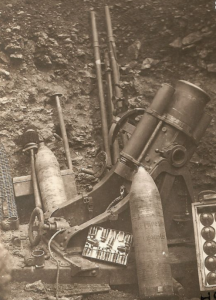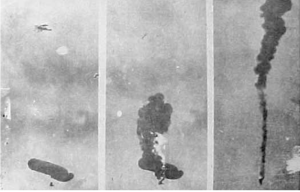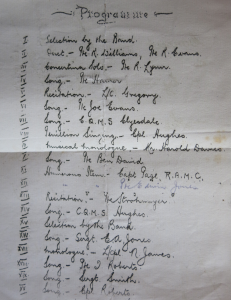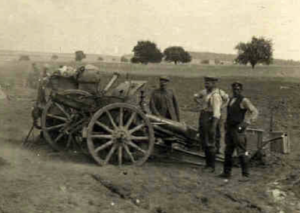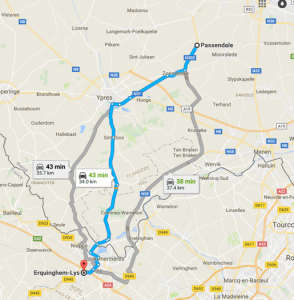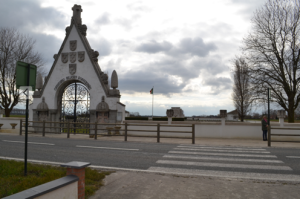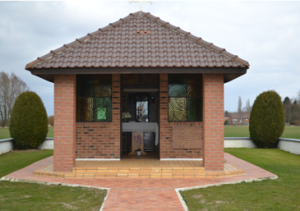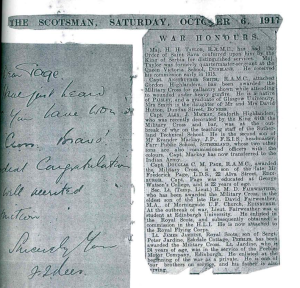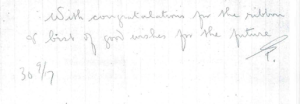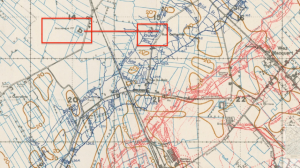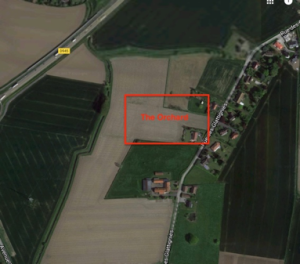Monthly Archives: October 2017
29th to 31st October 1917 Monday to Wednesday
German attacks from the trenches and the air
All material produced or reproduced here and throughout this work is the sole copyright of the author and the family of Doctor D.C.M. Page MC
It was back for another turn of duty in the trenches for the 13th Royal Welsh Fusiliers and their medical back up, Captain Page and his team of orderlies and stretcher bearers. Meanwhile the base at Desalanque Farm was taking a pounding from German trench mortars and aerial raids.
“We were back in the line on Monday, 29th October. On the 31st October the Huns shelled Desalanque Farm very heavily with 4.2 shells. Some of them dropped quite near us. His aeroplanes were very active too, and one of our captive balloons was brought down in flames.”
Find out about our connection with Dr Page and an introduction to his diary here
27th October 1917 Saturday
Saturday night treading the boards, but not duck boards.
All material produced or reproduced here and throughout this work is the sole copyright of the author and the family of Doctor D.C.M. Page MC
Douglas once again played an active part in not only preserving the lives and health of the men, but also entertaining them. Not for the first time in his service on the Western Front he helped to produce a concert party. Previously with the 130th St. John F.A. he had been part of a concert party known as the Dominoes.
As if it was just something that one does. Not merely understated, as most of his life was, but not stated at all. Something that obviously requires a lot of planning, a lot of practice, recruitment and rehearsal, goes almost unmentioned in his diary.
Luckily for us though he does mention it and leaves a copy of a programme for posterity.
“I organised a concert for the 27th. It was a huge success, and was attended by the General and his Staff and about 40 other officers. It was billed to commence at 7.30 p.m. but by 5.30 there was a queue of ‘Tommies’ half-way down the street. Quarter-Master H Davies was in great form, and I scored a hit with a Sam Mayo item. We gave a two hours’ show.”
Sam Mayo, real name Samuel Cowan was a popular Music Hall star born in 1881. He became famous for his musical comedy act and his comic songs were very popular at the time. You can view a lot of his monologues on this popular website.
Samuel Cowan died in 1938.
Maybe this was the number from Sam performed by Douglas, it is from 1916
It has survived across a century and the lyrics can be viewed on the above website.
Also a recording of his later work in 1932.
Find out about our connection with Dr Page and an introduction to his diary here
17th October to 23rd October 1917 Wednesday to Tuesday
Relieving the 16th RWF again
All material produced or reproduced here and throughout this work is the sole copyright of the author and the family of Doctor D.C.M. Page MC
It was back to the trenches for the 13th for another six day turn of duty, giving the 16th a few days’ rest. Fortunately, for all these men things were pretty quiet again.
“ Our six days’ tour of the trenches was most uneventful. Everything was very quiet. There was practically no shelling. Aerial activity, especially on the part of the enemy was very active. I spent a lot of time in making improvements at my Aid Post, and visiting the companies in the outposts. We moved out on the 23rd being relieved by the 16th R.W.F. as usual.”
Whiz-Bangs
I thought that perhaps during this period of relative inactivity for Douglas Page it might be a good time to explain one of the features of this website. The Whiz-Bang or its more common spelling of Whizz-Bang. The most common array of spellings are thus Whizz-Bang, Whiz-Bang, Whizz Bang or Whiz Bang.
This was a piece of German ordnance fired from a small field gun, the 7.7cm made by Krupp.
Capable of propelling a shell up to seven miles. It’s unlikely that the actual firing would be heard immediately as it could have been fired at least five miles away, but the shell arriving would have made a sudden whizzing sound followed by the bang of its explosion.
Despite its nickname sounding like a garden firework its deadly load was a fearsome and destructive weapon. Where a shell from a field gun would explode with ground contact it would normally leave a crater about 5 ft (1.5 mtr.) across and 2 ft (0.6 mtr) deep. These are rough approximate sizes not definitive crater sizes.
Find out about our connection with Dr Page and an introduction to his diary here
11th October to 17th October 1917 Thursday to Wednesday
Local peace breaks out for a week
All material produced or reproduced here and throughout this work is the sole copyright of the author and the family of Doctor D.C.M. Page MC
“We got back to Erquingham again on the 11th October, and had a quiet rest period which ended on the night of the 17th October.”
Although Douglas and his comrades were enjoying a restful period in their war, the scene elsewhere was less quiet, fighting around the Ypres area was as intense as at any other time.
General Price-Davies was busy along with other senior staff officers taking afternoon tea and playing badminton, wishing he was anywhere but on the Western Front. He described the scene for the area that Douglas found himself in. He mentioned the long front that had now been established to the south of Armentieres and “what a change it was to see grass and trees instead of shell swept battle front where everything is blown”.
It gives some idea of the change in the scenery, that despite the fighting continuing all along the front, there were places where it was less intense than others. Artillery had undoubtedly been concentrated further to the north to support the drive to capture the ground around Passchendaele, so maybe there were less big guns available to smash up the area around Erquinghem. The picture of remaining greenery was in stark contrast to the shattered trees and cratered mud-bath west of Ypres.
Only 2 days previously the Battle of Poelcapelle had taken place a few miles to the north. It was considered a successful defensive action by the Germans who inflicted 6957 casualties on the ANZAC troops that fought them. However, Germany suffered great loss in holding their position, sustaining 35,000 casualties.
On the 12th the first unsuccessful attack on Passchendaele was launched. Despite heavy losses on both sides, the attack faltered in the quagmire and was repulsed by the German 4th Army. Added to the bogged down troops and equipment, a breakdown in communications forced Haig to suspend the attack.
No exact date given but click here to see a photo from 1915-16 near Bois Grenier showing plenty of intact foliage. British line marked ‘O’ and the German ‘X’. (Awaiting permission for usage.)
Find out about our connection with Dr Page and an introduction to his diary here
October 7th to October 10th 1917 Sunday to Wednesday
Pork and Beans were the order of the day
All material produced or reproduced here and throughout this work is the sole copyright of the author and the family of Doctor D.C.M. Page MC
“One day 5 Portuguese officers and 16 other ranks came up to have a look round the lines. They had lunch and tea with us, and it was very funny trying to make conversation with them. Some of them spoke French, luckily. Three days later a whole battalion of them (‘Pork and Beans’) arrived for instruction. Their doctor was attached to me. He spoke French and I got on very well with him.”
The Portuguese had entered the war on the side of the Allies, mostly due to skirmishes against Germany in Africa where Portugal was attempting to protect her colonies such as Angola. German U-boats whilst trying to blockade Britain had attacked Portuguese shipping whilst trying to trade with Britain, at the time Portugal’s most important export market. Germany finally declared war on Portugal in March 1916 with the resulting loss of almost 8145 Portuguese troops killed, 13,751 wounded and 12,318 taken prisoner or reported missing . However the civilian population paid a far higher price with the loss through starvation and disease of a further 220,000.
Today, at Neuve Chapelle near Richebourg, is a large Portuguese cemetery for their fallen there.
Find out about our connection with Dr Page and an introduction to his diary here
6th October 1917 Saturday
Many Congratulations.
All material produced or reproduced here and throughout this work is the sole copyright of the author and the family of Doctor D.C.M. Page MC
Congratulatory notes continued to arrive for Douglas and on this Saturday an article appeared in the Scotsman newspaper. A note from Brevet Lieutenant Colonel John Gordon Rees was among those received.
“My Dear Page,
I have just heard that you have won the Military Cross. Bravo! My cordial Congratulations for this well merited distinction.
Sincerely Yours
J.G. Rees”
Colonel Rees was a regular soldier, a cavalry officer of the 13th Hussars, attached to the R.W.F. who served throughout the duration of the war.
We may have more on him in the future, as we discover more. Please feel free to contribute if you have any further information.
Find out about our connection with Dr Page and an introduction to his diary here
5th October 1917 Friday
A long stint ‘Up the Line’
All material produced or reproduced here and throughout this work is the sole copyright of the author and the family of Doctor D.C.M. Page MC
“We went ‘up the line’ on the evening of October 5th and took over from the 16th R.W.F. It was a long relief, and we didn’t get settled down until after 11 o’clock to our six days of trench life.
As before I visited the various posts each morning. I also planned and supervised the erection of our Advanced Aid Post in the Orchard, which would do for a resting place. when bringing wounded from the front posts to my Battalion Aid Post; or where I could be in the event of a ‘Straffe’ by either party – British or Hun.”
The 13th RWF relieved the 16th RWF as they alternated on 6 day shifts in the front line. This seems to have been an unusually long term of duty in the trenches and the men would have done well to enjoy their rest periods in between knowing it could be their last. The map above shows the short distance from Desalanque Farm to the area known as the Orchard where Douglas busied himself in finding a seemingly safe place to set up his A.D.S.
Find out about our connection with Dr Page and an introduction to his diary here
4th October 1917 Thursday
All material produced or reproduced here and throughout this work is the sole copyright of the author and the family of Doctor D.C.M. Page MC
“On the evening of Thursday, 4th October, Dr. Kelman of Edinburgh, lectured to us on ‘America and the War’. He was splendid. I had a chat with him at the close of the meeting, and when he saw my M.C. ribbon, he said: ‘Ah! Another ribbon for the Operetta House!’ – (referring to his Sunday evening student meetings in the old Operetta House, Edinburgh, which I attended regularly.)”
The Old Operetta House stood in Chambers Street, Edinburgh from 1871 to its final demise around 1951. Chambers Street was named after the famous Scots architect William Chambers who was actually born in Gothenburg, Sweden. Among his best known works are Somerset House in London and the Pagoda at Kew Gardens. He now proudly surveys the street from a pedestaled memorial in the middle of the street.
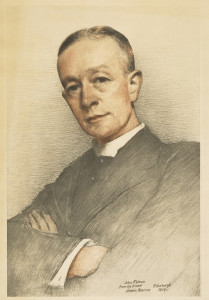
Dr. Rev. John Kelman 1864-1929 By James Paterson National Galleries of Scotland (Creative Commons) https://www.nationalgalleries.org/art-and-artists/33317/rev-john-kelman-1864-1929-writer
Dr. John Kelman was an established author and a prominent figure in the Presbyterian church, known for his lectures in both Britain and the United States. Described as one of the best known Ministers in Great Britain.
Find out about our connection with Dr Page and an introduction to his diary here
